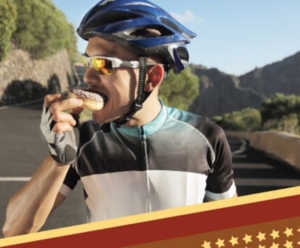Make a pit stop anywhere, anytime during your training rides with this Gas Station Refuel Guide
You pump up the bike tires, check your saddle height, cover yourself with sunscreen, you open the cupboard trying to figure out what to bring for a mid-ride snack, but nothing looks appealing. Instead of agonizing on what to bring, why not just ride “light” and stop at a gas station to refuel. Gas stations are everywhere. It is a good place to stop, take a break, stretch your legs, use the restroom and refuel. Here are some ideas on what to pick up from the gas station to refuel during training rides as you get ready for Kerrville Tri!
Short Ride Refuel
For short rides, 1 to 2 hours, a bottle of water, or your favorite electrolyte drink are great choices to rehydrate. If you notice that you’re hungry, go for a banana, energy bar, or even candy such as Skittles. These are all great ways to get some quick calories in. They are easy to digest and allow the body to absorb the calories quickly.
Refuel Guide for Medium Rides
For medium rides, 2 to 3 hours, in addition to water and electrolytes drinks, also consider having a coke. Studies that found that caffeine can enhance exercise performance. And for your snack, consider having something high in calories and with some fat. Food with a bit of fat will keep you feeling full. Muffins, Snickers, and trail mix are some great options. Keep a good balance of carbs, protein, and fat for sustained energy.
The Long Haul Refuel
For rides longer than 3 hours, consider getting food and drink that is appetizing and you’ll actually enjoy. If you have been on the bike for hours, the last thing you probably want is another gel or chew. On those hot days, an ice-cold soda or Red Bull is a great way to refresh yourself. Maybe even consider getting an ice cream sandwich. If the gas station is serving fresh-made food, that is a great option. A fresh-made hot breakfast taco is a great mood booster when you are in the middle of a long ride and feeling tired. The goal is to get food that you want to eat and get the needed calories to finish the ride strong.
You’re Ready to Ride!

Pro tip: Don’t forget to grab your debit card and look over these must-know rules of the road before you head out for your next ride! Now you know exactly what to eat to keep your energy levels where they should be during your workout. Next time you’re out for a training ride and don’t shy away from stopping at the closest gas station! With this Gas Station Refuel Guide, you’ll know exactly what you need to replenish your body so you can get back on the road!
If you have a favorite, go-to snack at the gas station you grab when you’re in need of a quick refuel, share it with us! We’re always looking for new snacks and treats to try during our training rides. We’re on Facebook and Twitter and would love to hear your suggestions.

